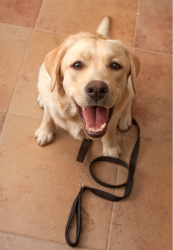How to Train Your Golden Retriever

It is hard to find a more beautiful, gentle and loyal dog than Golden Retrievers, and here are 7 Golden Retriever training tips to help you and your puppy have an even better relationship.
Retrievers, like other dogs, are used to being a part of the pack.It is the dog owners job to ensure that the new member of the family knows who is boss. Training provides safety for your pet in addition to establishing dominance.The most important training tips for your canine are as follows:
Tip 1: Crate Training/
Crates are an effective training tool and provide a positive experience for both you and your dog. Golden Retrievers, like others in the canine family, benefit from this modern version of a den, as their ancestors have used throughout history.
Crate training your puppy gives a pup a safe haven to rest. In addition, dogs don’t want to soil their dens, so it is a very effective housebreaking tool. In this way, your Retriever will enjoy having his own space and you will be able to quickly train your dog to not have accidents in the house.
As your dog grows, you should still offer a larger crate or special area in the house that is your Golden Retriever’s quiet place.
Tip 2: Stay
Many dog owners focus on basic training skills, but none is as important as teaching your Golden to stay. Especially in a young puppy, the temptation to chase rabbits or squirrels when outdoors can be irresistible to a pup. However, the end result can be tragic when an owner doesn’t have control.
A distracted, enthusiastic dog can inadvertently put himself in harm’s way, not paying attention to oncoming cars or other hazards. In addition, as your dog ages, he or she might be docile and loving, but another dog passing by, that your dog runs up to with exuberance, might not be.
The goal is to ensure that no matter how tempting a distraction might be, your Retriever will stay at your side, when you give the command.
Tip 3: Sit
Teaching a dog to sit is one of the basic training skills dog owners work on with their new puppies. Sitting teaches your Golden Retriever to calm down as well as learning to listen to your commands.
Dogs can be told to sit before giving them their food or treats, to avoid the jumping and hysteria that can accompany a Golden’s love of food.
Learning to sit also is useful for safety, ensuring that your dog will remain at your side when outside, putting on a leash or any other time when you are in need of your dog remaining still, for your convenience or your dog’s safety.
Tip 4: Handling Separation
Golden Retrievers are loyal companions who thrive on being around others. They love being a part of the “pack.” However, this can become problematic when left alone, if they’ve never been exposed to it before.
Dog owners may be tempted to bring their canine companions everywhere with them, but this doesn’t prepare them for unexpected times when they might have to be home alone.
Separation anxiety can lead to destructive, attention seeking behaviors. Even as puppies, it is recommended that you leave your pup alone for brief intervals.
Let your dog see you come and go, and do not make a large production out of the event. When your Golden sees that you do leave, but always come back, there will be little anxiety when you actually do need to leave him or her behind.
Tip 5: Down
With Golden Retrievers comes an amazing supply of never ending energy. Sometimes, an overly excited dog can get carried away, jumping on people, knocking things down and, even worse, knocking people or small children over.
Golden’s are loving and playful, but as they grow bigger, their size can lead to injury and damage that didn’t seem possible when they were puppies.
Teaching your dog commands like down and off when they are young will reduce the likelihood of more serious problems when they are older. In addition, your dog needs plenty of exercise each day to help burn off that energy.
Tip 6: Come
Similar to the objectives of the stay command, teaching your dog to come in a setting that is free of distractions will ensure that, in the event your dog strays or chases after another animal or vehicle, he will immediately return to your side, safe and sound.
There are times when the stay command cannot be implemented quickly enough, and that is where come takes over.
Tip 7: Heel
Many dog owners do not provide their dogs with proper exercise requirements simply because they cannot control their dog when out in public. Golden Retrievers are large dogs and they can easily be taking their owners for a walk, instead of the other way around, if they haven’t been trained to heel. Heeling should entail that your dog is walking at your side, not leading you.
If your dog always needs to be in front, you can be certain that he believes he is dominant over you. When your dog heels, it is not only a more enjoyable walking experience that provides safety for your dog, it establishes your dominance over your Golden Retriever, which is essential for successfully implementing any other training skills.
By Michelle L.
